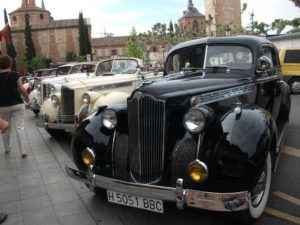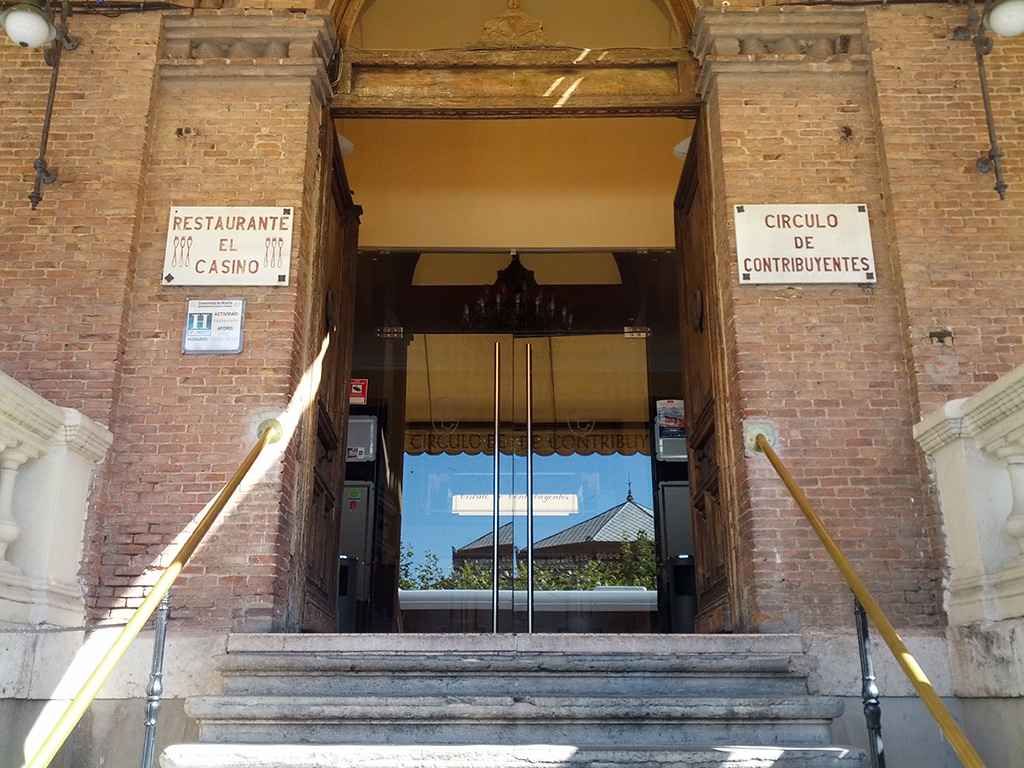Este texto también está disponible en Español
Círculo de Contribuyentes is one of the most representative buildings of plaza de Cervantes and has, in its own right, an outstanding place into Alcalá de Henares’ history.
This nineteenth-century building placed in the middle of plaza de Cervantes was and still being the head office of Condueños Society—one of the institutions Alcalá is more indebted to. It is located next to the old Cervantes Hotel, an additional building also built up by the Society in 1914.
Círculo de Contribuyentes was built up in 1893 by the local architect Martín Pastells upon what it was, in time of Cisneros Cardinal, the houses of students. It is made up by exposed bricks with the characteristic Neo-Mudéjar style of that period, the same present also in Laredo’s Palace, the old Slaughterhouse or the core of Burgo de Santiuste Interpretation Center.
It has three different architectonical elements among which it stands out its wonderful large windows with Roman arches and its entry—culminated by a curious barometer, not a clock. The device was donated by Carlos Lardet, watchmaker, Consul General of Switzerland in Spain and owner of Laredo’s Palace, constructed by his friend Manuel Laredo.
The entry, on the first floor, is accessed through a wide flight of steps with limestone bannisters and sided by two wonderful flowerbeds.
The building has two floors and a lower ground floor, along with three inside patios. Today, besides being the official headquarter of Condueños Society, it holds the restaurant El Casino, name inherited from its old usages.
The masterpiece of its inside is the Noble Hall, in which several paintings made in 1901 by the notable painter of Alcalá, Félix Yuste, can be admired. Similar to huge tapestries, the identity of Alcalá’s inhabitants and their relation with their history is perfectly reflected in a wonderful canvas titled “Apotheosis of Alcalá”.
The painting decorating the ceiling, made by Samuel Luna in 1906, should be also pointed out. The decorating—the playing-card tables and the whole ensemble in general—creates an environment with reminiscences of Benito Pérez Galdós novels.
To immerse you even more in that sensation, try visiting the building during the celebration of the Vintage Cars Touristic Tour of the Community of Madrid, where car owners precisely park in front of the stairs of Círculo de Contribuyentes (additional information).

Condueños Society
The phrase “essence keeper” totally makes sense when talking about Condueños Society of Alcalá de Henares, whose headquarter is placed inside Círculo de Contribuyentes. Such society was the first private non-profit-making association created in Europe, on purpose, for preserving the historical heritage of the city.
Thus, it is thanks to Condueños Society, founded in 1851, that today we can enjoy the square where the university—the very same university built up by Cardinal Cisneros at the beginning of sixteenth century—and all surrounding buildings are found, instead of being abandoned and threaten to collapse.
The reason is that after the Ecclesiastical Confiscations of Mendizábal, the institution of the university along with its heritage and its archives were moved to Madrid in 1836, where it received the name of Central University of Madrid. Later, in 1968 and after the creation of the Autonomous University of Madrid, it acquired the name it currently holds of Complutensian University of Madrid. However, it is worthy to remember that Complutum is the old name of Alcalá in its Roman period, so saying complutensian is synonymous of saying Alcalá’s.
In that moment, Queen Isabella II ordered the auction of the building—of great historical and artistic richness—to the best bidder.
Silkworms in the Paranymph
However, following in line with the discovering of the remains of Cardinal Cisneros, a group of Alcalá’s neighbors—the city held at that time 7000 inhabitants—decided to join and save the university from the unceasing pillaging suffered.
This citizen agreement was produced after several ups and downs of the university goods. After the ecclesiastical confiscations and the royal decree to put the buildings out for auction, Joaquín Alcober was headed to the Board of Public Instruction in 1845. There, he offered the amount of 50,000 reales [old Spanish coin] to dedicate San Ildefonso Hall of Residence, its gardens and other buildings, to mulberry tree cultivation and silkworms breeding, as well as the construction of a spinning factory.
A year later, the buying by Mr Alcober was closed, who in turn sold again the university buildings a year after to Joaquín Cortés for 70,000 reales, who resold them in 1850 to the Earl of Quinto and his wife, Elisa de Rodas.
The couple would not sell it, though they would transform it as they wish and took every object they wanted to other lands of their property, constituting a real sacking. They took, for instance, the bell on the top of San Ildefonso chapel to their properties in Aragón, demolished an arch linking the university with the building in front of it in calle Pedro Gumiel, and took numerous works of art, paintings, altarpieces and grilles.
When it was spread the rumor that they were thinking about dismantle the university façade, a great number of neighbors signed a document addressed to the mayor, asking him to stop the sacking.
Promptly, a meeting was celebrated into the Archbishop’s Palace gathering the living forces of the city with the mayor, and creating a commission made up by seven notables—among who there were the Archbishop of Toledo and the marquis of Morante—in charge of doing all necessary paperwork to acquire the estates of the university.
Prints of A Hundred Reales
The commission stipulated the rules for the creation of Condueños Society and gathered the money of Alcalá’s inhabitants who supported such venture. Nine hundred shares or stocks of the property, named prints, were issued. Each one of those prints had a value of one hundred reales, the only condition members had are that such prints could not be transferred to people from outside Alcalá and that each owner could possess a maximum of ten prints.
Condueños Society of Old-University Buildings was created in January 1851, before the city’s notary, Gregorio Azaña, after a month of the purchasing of university buildings by its members for 90,000 reales.
The beneficial effects of the safeguarding made by Condueños Society upon Alcalá’s historical heritage was extended along a century and a half until the reopening of the university of Alcalá in 1977, when the society transferred the property to them for a symbolic rental.
It is interesting to remember that, when Condueños Society was founded, the Archbishop’s Palace was also put up for sale for a million reales, though, fortunately, no buyer was found.
If you want to know more in depth about what happened in Alcalá, the university and its most representative nineteenth-century buildings, do not miss this interesting document published by the City Hall of Alcalá de Henares.
Additional Information:
- www.restauranteelcasino.com
- es.wikipedia.org
- www.portal-local.es
- www.ayto-alcaladehenares.es
- www.alcalavirtual.es
- blog-goyo.blogspot.com.es
Useful information:
- Address: Plaza Cervantes, 9
- Telephone: +34 91 888 00 89
- Web: www.restauranteelcasino.com
Access from Madrid
- Renfe Cercanías railroads C-1, C-2 and C7A.
- Bus nº 223 (departure from Avenida de América Interchanger).
Image gallery:
[gdl_gallery title=»circulo-de-contribuyentes» width=»120″ height=»95″]
On video:
Where is it
Sigue disfrutando de Dream Alcalá:
- Telegram: Recibe nuestras noticias y contenido exclusivo (clic aquí).
- Newsletter: Recibe cada tarde un correo con nuestras últimas noticias (clic aquí).
- YouTube: Suscríbete para ver nuestros mejores vídeos (clic aquí).
 Sé tú el periodista: envíanos tus fotos o noticias a través de Telegram.
Sé tú el periodista: envíanos tus fotos o noticias a través de Telegram.

